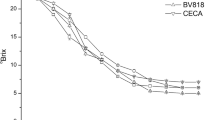Abstract
Some tropicalSaccharomyces cerevisiae strains, isolated fromChampús, a traditional Colombian low alcoholic fermented beverage, were characterised in order to select yeasts for aroma improvement in wine. H2S production, volatile acidity, β-glucosidase activity, higher alcoholesters and terpenes production were evaluated in this study. These tropical strains were characterised by a considerable production of ethyl hexanoate, 2-phenylethanol, 2-phenylethyl acetate, and geraniol, detected by SPME-GC-MS. Odor activity values were calculated to analyse the effects of yeasts strains on wine aroma, resulting in six distinctive wine groups, as evidenced by discriminant analysis. These results suggest thatSaccharomyces strains isolated fromChampús can be an important source for new tropical yeast biotypes with potential winemaking applications, producing a wide range of aroma compounds.
Similar content being viewed by others
References
Buzzini P., Martini A., Cappelli F., Pagnoni U.M., Davoli P. (2003). A study on volatile organic compounds (VOCs) produced by tropical ascomycetous yeasts. Antonie Leeuwenhoek, 84: 301–311.
Carrau RM., Medina K, Boido E., Farina L, Gaggero C, Dellacassa E., Versini G., Henschke P.A. (2005).De novo synthesis of monoterpenes bySaccharomyces cerevisiae wine yeasts. FEMS Microbiol. Lett., 243: 107–115.
Clemente-Jiménez J. M., Mingorance-Cazorla L, Martinez-Rodriguez S., Las Heras-Vázquez F.J., Rodríguez-Vico F. (2005). Influence of sequential yeast mixtures on wine fermentation. Int. J. Food Microbiol., 98: 301–308.
Di Maro E., Ercolini D., Coppola S. (2007). Yeast dynamics during spontaneous wine fermentation of the Catalanesca grape. Int. J. Food Microbiol., 117: 201–210.
Donalies U., Nguyen H., Stahl U., Nevoigt E. (2008). Improvement ofSaccharomyces yeast strains used in brewing, wine making and baking. Adv. Biochem. Engin/Biotechnol., 111: 67–98.
Esteve-Zarzoso B., Gostincar A., Bobet R., Uruburu F, Querol A. (2000). Selection and molecular characterisation of wine yeasts isolated from the “El Penedès” area (Spain). Food Microbiol., 17: 553–562.
EU Official Gazette (1990). L 272, Luxembourg, Oct 3.
Ezeronye O.U. (2004). Nutrient utilization profile ofSaccharomyces cerevisiae from palm wine in tropical fruit fermentation. Antonie Leeuwenhoek, 86: 235–240.
Fleet G.H. (2007). Yeasts in foods and beverages: impact on product quality and safety. Curr. Opin. Biotechnol., 18 (2): 170–175.
Frijters J.E.R. (1979). Some psychophysical notes on the use of the odour unit number. In: Land D., Nursten H., Eds, Progress in Flavour Research, Applied Science, London, pp. 47–51.
Garde-Cerdán T., Ancín-Azpilicueta C. (2006). Contribution of wild yeast to the formation of volatile compounds in inoculated wine fermentations. European Food Res. Technol., 222: 15–25.
Gil M., Cabellos J.M., Arroyo T., Prodanov M. (2006). Characterization of the volatile fraction of young wines from the Denomination of Origin “Vinos de Madrid” (Spain). Anal. Chim. Acta, 563: 145–153.
Giudici P., Kunkee R. E. (1994). Effect of nitrogen deficiency and sulphur-containing amino acids on the reduction of sulphate to hydrogen sulphide by wine yeast. Am. J. Enol. Vitic, 45 (1): 107–112.
González S.S., Gallo L, Climent M. D., Barrio E., Querol A. (2007). Enological characterization of natural hybrids fromSaccharomyces cerevisiae and S.kudriavzevii. Int. J. Food Microbiol., 116: 11–18.
Kurtzman C. P., Fell. J.W., Eds (1998). The Yeast: A Taxonomic Study. 4th edn., Elsevier Science B.V., Amsterdam.
Lachance M., Starmer W.T. (1998): Ecology and yeasts. In: Kurtzman C.P., Fell J.W., Eds, The Yeasts: A Taxonomic Study, 4th edn., Elsevier Science B.V, Amsterdam, pp. 21–30.
Mallouchos A., Komaitis M., Koutinas A., Kanellaki M. (2002). Investigation of volatiles evolution during the alcoholic fermentation of grape must using free and immobilized cells with the help of solid phase microestraction (SPME) headspace sampling. J. Agric. Food Chem., 50: 3840–3848.
Mingorance-Cazorla L., Clemente-Jiménez J. M., Martinez-Rodriguez S., Las Heras-Vázquez F.J., Rodríguez-Vico F (2003). Contribution of different natural yeasts to the aroma of two alcoholic beverages. World J. Microbiol. Biotech., 19: 297–304.
Morais P.B., Hagler A.N., Rosa, CA., Mendonça-Hagler L.C., Klaczko L.B. (1992). Yeasts associated withDrosophila in tropical forests of Rio de Janeiro, Brazil. Can. J. Microbiol., 38: 1150–1155.
Osorio-Cadavid E., Chaves-López C, Tofalo R., Paparella A., Suzzi G. (2008). Detection and identification of wild yeasts inChampús, a fermented Colombian maize beverage. Food Microbiol., 25: 771–777.
Regodón Mateos J.A., Pŕrez-Nevado F., Ramírez Fernández M. (2006). Influence ofSaccharomyces cerevisiae yeast strain on the major volatile compounds of wine. Enzyme Microb. Techn., 40: 151–157.
Ribeiro M.J.S., Leão L.S.C., Morais P.B., Rosa CA., Panek A.D. (1999). Trehalose accumulation by tropical yeast strains submitted to stress conditions. Antonie Leeuwenhoek, 75: 245–251.
Rojas V., Gil J.V., Pinahaga F., Manzanares P. (2003). Acetate ester formation in wine by mixed cultures in laboratory fermentations. Int. J. Food Microbiol., 86: 181–188.
Sánchez Palomo E., Díaz-Maroto M.C., González Viñas M.A., Soriano-Pérez A., Pérez-Coello M.S. (2007). Aroma profile of wines from Albillo and Muscat grape varieties at different stages of ripening. Food Control, 18: 398–403.
Torrea D., Fraile P., Garde T., Ancín C. (2003). Production of volatile compounds in the fermentation of Chardonnay musts inoculated with two strains ofSaccharomyces cerevisiae with different nitrogen demands. Food Control, 14: 565–571.
Valero E., Moyano L, Millan M.C., Medina M., Ortega J.M. (2002). Higher alcohols and esters production bySaccharomyces cerevisiae. Influence of the initial oxygenation of the grape must. Food Chemistry, 78: 57–61.
Vaudano E., Garcia Moruno E., Di Stefano R. (2004). Modulation of geraniol metabolism during alcohol fermentation. J. Inst. Brew., 110: 213–219.
Vincenzini M., Romano P., Farris G.A., Eds (2005). Microbiologia del Vino. Casa Editrice Ambrosiana, Milano.
Zoecklein B.W., Marcy J.E., Williams J.M., Jasinski Y. (1997). Effect of native yeasts and selected strains ofSaccharomyces cerevisiae on glycosyl glucose, potential volatile terpenes, and selected aglycones of White Riesling (Vitis vinifera L.) wines. J. Food. Comp. Anal., 10: 55–65.
Author information
Authors and Affiliations
Corresponding author
Rights and permissions
About this article
Cite this article
Chaves-López, C., Serio, A., Osorio-Cadavid, E. et al. Volatile compounds produced in wine by Colombian wildSaccharomyces cerevisiae strains. Ann. Microbiol. 59, 733–740 (2009). https://doi.org/10.1007/BF03179216
Received:
Accepted:
Issue Date:
DOI: https://doi.org/10.1007/BF03179216




